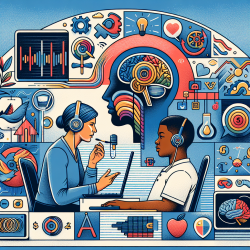Introduction
The COVID-19 pandemic has necessitated rapid adaptations in healthcare delivery across various disciplines. The research article "Managing Severe Aortic Stenosis in the COVID-19 Era" provides valuable insights into how cardiology has adapted to the challenges posed by the pandemic. These strategies, particularly the emphasis on virtual assessments and minimizing patient exposure, can be effectively translated into the field of speech-language pathology (SLP) to improve outcomes for children.
Virtual Assessments and Consultations
One of the key strategies highlighted in the article is the transition to virtual assessments and consultations. In speech-language pathology, teletherapy has become an essential tool to continue providing services to children during the pandemic. Data-driven approaches can enhance the effectiveness of teletherapy by:
- Utilizing standardized assessment tools that are validated for virtual administration.
- Incorporating parent and caregiver input to gain a comprehensive understanding of the child's communication environment.
- Leveraging technology to track progress and adjust therapy goals in real-time.
Minimizing Exposure and Resource Utilization
The cardiology field has focused on minimizing patient exposure to COVID-19 by reducing unnecessary hospital visits and admissions. Similarly, speech-language pathologists can minimize in-person interactions by:
- Conducting initial evaluations and follow-ups virtually, reserving in-person sessions for cases where hands-on assessment is critical.
- Using remote monitoring tools to assess speech and language development, such as apps that track speech patterns and language use.
- Collaborating with other healthcare providers to ensure a coordinated approach to care that reduces the need for multiple appointments.
Innovative Use of Technology
The article highlights the potential of wearable and remote devices in cardiology to assess patient performance and vital signs. In SLP, innovative technology can be used to enhance therapy outcomes by:
- Implementing speech recognition software to provide immediate feedback on articulation and fluency.
- Using video modeling and virtual reality to create immersive language learning experiences.
- Incorporating gamification to engage children and motivate practice outside of therapy sessions.
Conclusion
As we navigate the challenges posed by the COVID-19 pandemic, it is crucial to adopt data-driven strategies and leverage technology to enhance the delivery of speech-language pathology services. By learning from the innovative approaches in cardiology, we can improve outcomes for children and ensure that they continue to receive high-quality care.
To read the original research paper, please follow this link: Managing Severe Aortic Stenosis in the COVID-19 Era.










